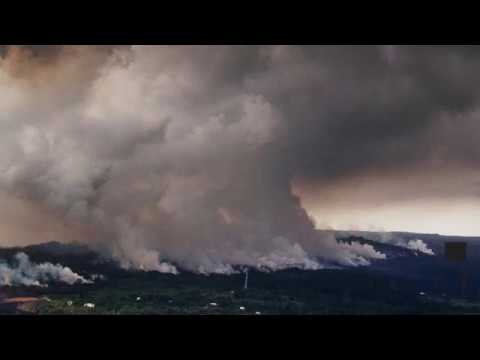
An eruption from the Kilauea volcano's summit shot ash and smoke into the air early Thursday on Hawaii's Big Island, and the resulting plume is expected to cover the surrounding area, according to the Hawaiian Volcano Observatory.
The volcanic cloud reached 30,000 feet, the US Geological Survey said. That's a little below the cruising altitude of a jetliner.
"At any time, activity may again become more explosive, increasing the intensity of ash production and producing ballistic projectiles near the vent," the USGS said. "Ballistic projectiles may be produced should steam-driven explosions occur. Impacts will be limited to an area around Halemaumau."
Halemaumau is the crater within Kilauea's summit caldera.
Thursday's eruption is just the latest volcanic activity contributing to the nightmare on the Big Island since the volcano first went off May 3.
An ash plume Wednesday rose roughly 12,000 feet into the air, and on Tuesday, the USGS issued a red alert, which means a major eruption is imminent or underway and ash could affect air traffic.
It is not clear if Thursday's was a phreatic eruption, which USGS officials have been saying is capable of sending ash plumes as far as 12 miles away from the summit.
The lava lake in the crater has been dropping since May 2, which increases the chances for a phreatic explosion, but it will be difficult to warn residents.
Phreatic eruptions are "notoriously hard to forecast, and can occur with little or no warning," Hawaiian Volcano Observatory geologist Janet Babb said.
Recent explosions have been steam-driven, occurring when water beneath the ground or on the surface is heated by magma, lava, hot rocks or new volcanic deposits, the USGS says.
While the ash being launched into the sky is not poisonous, Hawaii County officials have warned residents about toxic sulfur dioxide seeping out of 21 fissures caused by the volcano.
"Severe conditions may exist such as choking and inability to breathe," the county's Civil Defense Agency said Wednesday. "This is a serious situation that affects the entire exposed population."
Follow N1 via mobile apps for Android | iPhone/iPad | Windows| and social media on Twitter | Facebook.
Kakvo je tvoje mišljenje o ovome?
Pridruži se raspravi ili pročitaj komentare



 Srbija
Srbija
 Bosna i Hercegovina
Bosna i Hercegovina
 Slovenija
Slovenija







